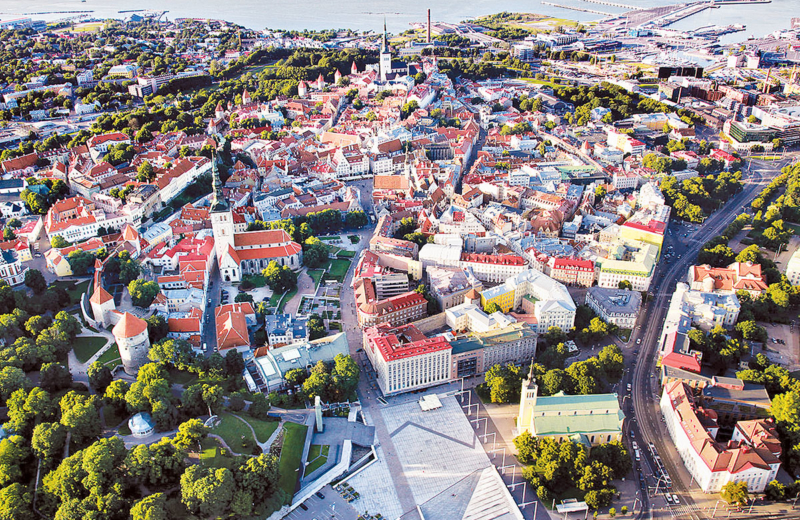TALLINN, Estonia — With a mild climate, coniferous forests and cold northern seas, Estonia sounds like the perfect place to get away from the summer heat. Once a part of the Soviet Union, today the country features relics of its communist past, medieval architecture and modern innovations.
Estonia regained its independence in 1991 after the breakup of the Soviet Union, at the same time as Ukraine.
However, it has outmatched Ukraine, and all other former Soviet republics, in terms of its development. Free public transport for locals, online voting in elections, easy access to residency permits for foreigners — those are just some of the successes Estonians like to share. A member of the European Union since 2003, the country has the highest gross domestic product per capita of the post-Soviet countries.
As a small nation of 1.3 million people, Estonia was long ruled by stronger neighbors — including Denmark, Germany, Sweden, and Russia. All of the former rulers have contributed to what Estonia has become today.
Medieval Tallinn
The best place to start exploring Estonia is its capital, the city of Tallinn. The small and cozy Tallinn airport, located right in the city, is the main air gate to the country. On arrival, take a tram or a bus to the city’s historic downtown.
The city was partly destroyed by the Nazis and then by the Soviets, but managed to preserve some of its 12th‑14th-century buildings, and reconstructed the rest. A UNESCO site, the Old Town is a mix of narrow cobblestone streets, traditional churches, craft stores, and hidden cafes, bars, and restaurants. The main attractions in the city center are all accessible by foot.
Today, the nation speaks mainly Estonian, but Russian is also widely used. Locals increasingly have a decent knowledge of English, especially among young people, as Russian is not an obligatory language in schools anymore.
A free old-town walking tour is a great way to explore places for the price of a tip for the guide. A tour guide with a great sense of humor breaks all of the stereotypes about the cold Nordic mood of Estonians. A two-and-a-half-hour tour starts every day at 12 p. m. from the corner of Harju and Niguliste streets.
After getting a feel for the tangled streets in the center, it is worth staying and exploring downtown some more. Go to St. Olaf’s church, a 12th-century place of worship, and climb the winding staircase to the tower’s observation platform for probably the best view of thecity, including the Baltic Sea. The entrance fee is 3 euros.
For a great view outside of the city, there is Tallinn TV Tower, which provides a 360-degree view of the city and surrounding area.
Next, take a walk around Toompea hill, a medieval fortress on a hill, with a tower and government buildings, which has two viewpoints from the walls. The numerous local restaurants there offer European, Nordic, Estonian and even some traditional Soviet food, including a lot of white fish, rye bread, and pork.
As Estonia is almost 60 degrees north of the equator, it has a “White Nights” season during the summer, when the nights never become fully dark around the summer solstice on June 21.
Relics of the country’s Soviet past can still be found in Tallinn, a prominent one being the Viru Hotel. The first high-rise building in the country, the hotel was constructed to host tourists from Western countries in rooms equipped with spying devices. The KGB Soviet security agency eavesdropped on the guests from their office on the 23rd floor, which is now a museum.
In the north of downtown is Kalamaja district, with its colorful two- and three-story houses. The district, which is located next to the sea, was once home to fishermen, but now is a popular residential area for local hipsters. A former industrial complex on the borders of the Old Town and Kalamaja, now called Telliskivi Creative City, is the place to go to hang out with local producers, tech company workers, as well as to try Estonian craft beer and homemade ice-cream.
Although Estonia is famous for having cold, bracing weather, climate change is making warm weather more frequent. To enjoy it, one should visit Pirita beach — if not for swimming, then for taking water sports lessons.
Outside the city
Estonians are proud of their relations with their neighbor across the sea, Finland. From Tallinn, it takes only two hours on a fast ferry to get to Helsinki. The ferries depart from D-terminal six times per day.
For active sports lovers, Estonia offers a network of bicycle roads that lead through forests, around lakes, and through villages. From Tallinn, take the EuroVelo 10 road between the coast and woodland to see white sandy beaches and to get to the country’s large islands. On one of them, Saaremaa Island, boasts nine meteorite craters near the village of Kaali.
To see more of the country, visit the students’ city of Tartu, famous for its old university. Another option is to go to Narva, a city on the border with Russia, where the majority of locals barely speak any Estonian.
Where to eat in Tallinn:
Cafe Grenka, 76 Pärnu Highway. Try farmer’s cheese pancakes syrnyky with sour cream or grilled bread grenka with duck fillet and vegetables.
F-hoone Restaurant, 60A Telliskivi St. Try Pumpkin and chickpea falafel with rocket-quinoa salad and cashew cream and a glass of local beer or cider.
For vegetarian options, go to Vegan Restoran V on 12 Rataskaevu St. Take beetroot ravioli with cashew cheese and a glass of wine.
How to get to Tallinn:
Direct two-hour flights from Kyiv to Tallinn are operated by Wizz Air and LOT airlines.



